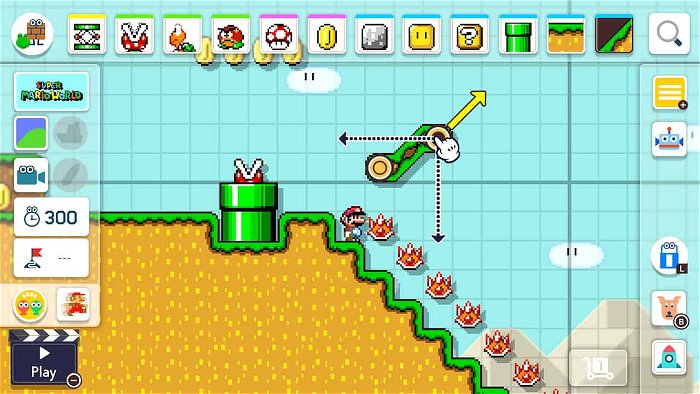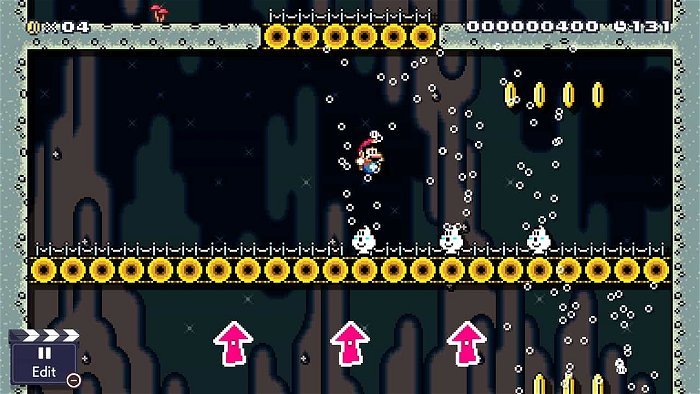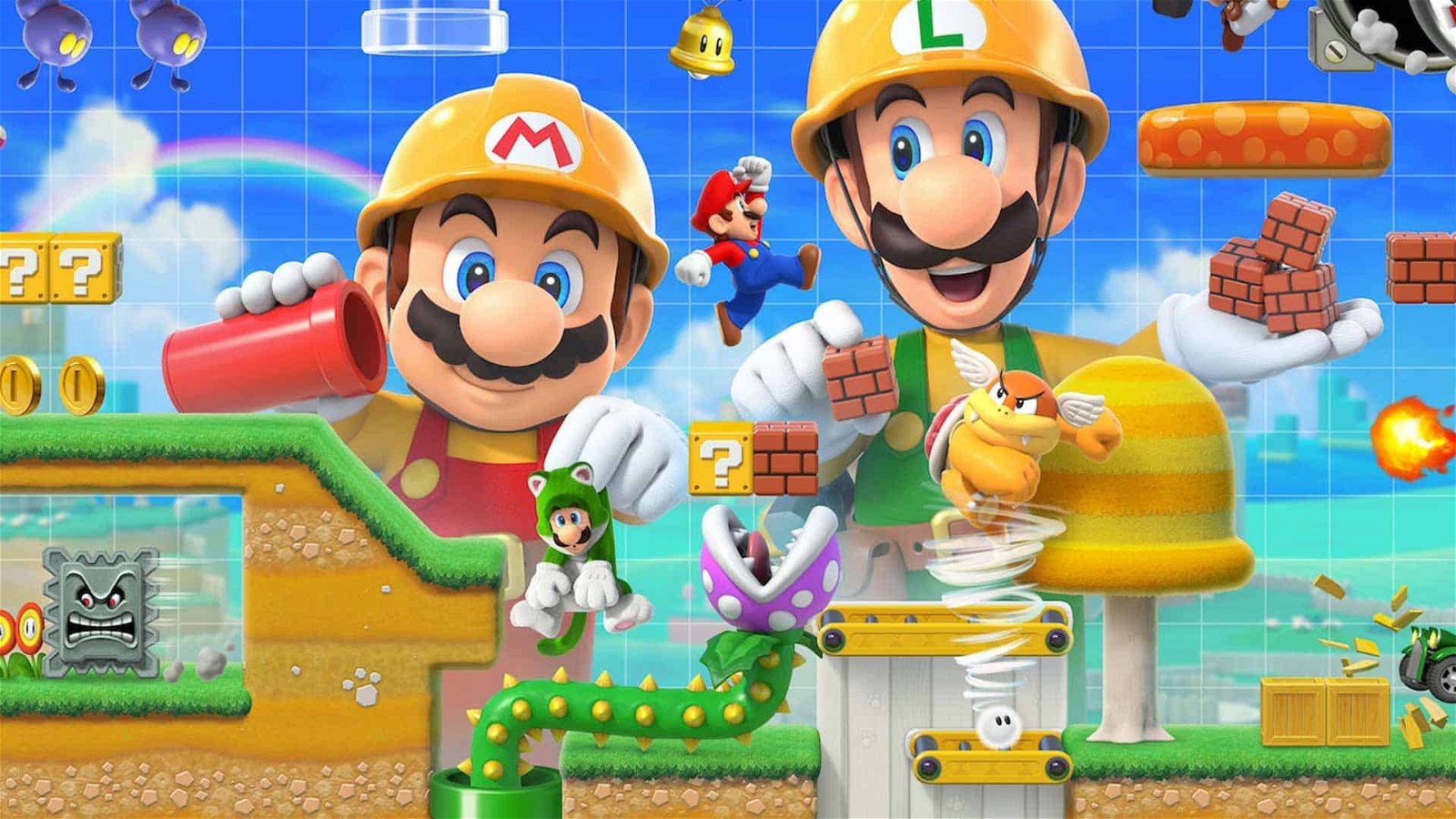Like its predecessor, Super Mario Maker 2 is three things: an exceptional 2D platformer complete with dozens of challenging and imaginative stages; a level editor filled with everything needed to equip both the novice and the seasoned creator; and a hub to discover and play user-created levels. The first two legs of this tripod have been improved and expounded upon greatly from the original, while the third appears generally unchanged and limited. It’s unfortunate, especially considering how strong the demand was (amongst Mario Maker’s active fanbase) for things like a course curation system and more streamlined browsing experience to find creators and levels.
I didn’t care one bit about that third leg while I was blasting through the Story Mode, nor while I was meticulously crafting my own eight-stage world. Super Mario Maker 2 comes with an overwhelming number of excellent levels worthy of any mainline 2D Mario title, and a level editor fully equipped with every tool the most imaginative Mario Maker creators could ask for—and more!

Begone, Fear of the Blank Canvas!
While I was an avid player of the first Super Mario Maker, looking up levels on Reddit and trying my friends’ and colleagues’ creations, I was not much for crafting levels myself. I found it to be intimidating., and I struggled with the frameworks of level design—the actual placement of platforms and pathways from left to right. The included handbook and prepackaged levels helped give me ideas, but I never gained the confidence to create levels all of my own from scratch.
I felt the same trepidation when first diving into Super Mario Maker 2’s Course Maker. Fortunately, every item, tool, and course type is available from the get, and everything is sorted out neatly in an easy-to-use weapon-wheel format. Courses translate one-to-one when switching from the Super Mario Bros. 3 aesthetic to that of Super Mario World, and vice versa. I can pin specific items to my toolbar, select multiple blocks to move, copy and paste, zoom out to view the whole course, and—most notably—create slopes, both steep and shallow! Everything I could think to put in my level was readily available and easy to implement. The game does everything it can to get out of my way so I can make what I want how I want. Nevertheless, I still froze up when designing a level structure. The blank canvas proved too intimidating for me.
I stuck with browsing Course World and chipping away at Story Mode until I took note of the title screen. In both Mario Maker games, the title screen loads up one of several demo levels, each generally short and often void of any enemies. What they do have is a basic framework—the very element I struggled getting my head around.
One day, a Ground-Theme level in the style of Super Mario Bros. 3 seized my attention. Three platforms rose from the ground on the first screen, Mario standing on the first. I clicked the shoulder buttons, clicked “Make,” and I was in the editor. I dropped a Koopa on the second platform, then a Hammer Bro on the third. After erasing the safety net below the three platforms, I clicked the minus button and started playing. After that, I began nudging; a block up for this enemy, a couple blocks down for this question block, maybe put wings on this Koopa. “What if the platforms were mushroom trees instead of ground blocks?” I thought. They function the same, but the trees give the impression of high altitude.

Wham! It hit me: my level would be Hammer Bros in the sky. A parade of Hammer Bros, some in the trees, some on clouds, some riding on flying Koopas! I spend hours on the level, testing it with playthroughs, making adjustments, cutting entire sections. Sometimes working on my home monitor with the Switch docked, sometimes on the train to work. It’s finally time to upload my level, so I start the “clear check” (every level needs to be beaten by the creator before getting uploaded). It takes me several dozen tries, but I finally clear my own stage. I make my friends play it. They cuss and shout, cursing me for every rogue hammer that catches them. I laugh.
Super Mario Maker 2 begs the player to get creative, and is willing to meet me on any level. At any point, whether playing a user-created level in Endless mode or one of the many Nintendo-designed levels in Story Mode, I can hit the minus button on my Switch and pull that level into Course Maker, making my own edits or crafting a new iteration. Over a dozen demo courses appear at the title screen, inviting me to fill them with oversized Chain Chomps. Even the infamous Assist Block has been replaced with the option to make quick edits to any level at the press of a button. Super Mario Maker 2 at no point forces me to create; I can play it like any mainline Mario game if I want. But it succeeds in making me want to create.
For the Play-Only Crew
While I enjoyed crafting my own levels, the main pull of Super Mario Maker 2 for me was Story Mode and its over 100 levels designed by Nintendo. While Super Mario Maker on Wii U also came with its own pre-made levels, these were unchallenging and merely served to showcase the different systems and tools available to the player. The levels of Super Mario Maker 2’s Story Mode serve the same purpose, but also astounded me with their imaginative designs. It starts off slow, but a dozen levels into Story Mode, I was jumping through gravity-shifting warp pipes, swinging between clawed ropes and chains, driving over Goombas in a go-kart, hopping on pinball bumpers riding along a midair conveyor belt—the number of new elements Nintendo has added to the already robust toolset of Mario’s systems is staggering.
In particular, “clear conditions” and On-Off TKTK switches open up the design opportunities in Mario levels exponentially. Instead of simply reaching the end of a level alive, players can now be set win conditions like “collect 100 coins,” “defeat 20 Bullet Bills,” or “complete as Super (big) Mario.” On-Off switches correlate to red and blue blocks which can appear and disappear respectively when the switch block is triggered. The obvious application here is making platforms that alternate, but these prove to have far more potential throughout Story Mode. It’s amazing how much these rules open up a game that has remained relatively consistent in its ruleset and capabilities since the ‘80s.

Equally impressive is how some of these levels use the franchise’s classic enemies and items in ways I’ve never seen before. In one level, I found a mountain of winged Munchers and a lone Shoe Goomba. The Munchers were hopping off each other so as to create three floating platforms that I could climb while wearing the green shoe. Munchers have been in /Mario/ games since Super Mario Bros., yet I never would have thought to arrange them like that. It’s surprises like this that make Nintendo’s home-brewed levels so rewarding.
The overworld of Story Mode takes place at the construction site where Mario and the Toads are rebuilding Peach’s castle. To rebuild, you must earn coins by completing levels commissioned by the blue Toad. You then pay the pink Toad—honorably referred to as the Chief—to make improvements on the castle. You can also speak to other Toads around the castle’s exterior for bonus levels, though these are all available in the aforementioned blue Toad’s list of “jobs” anyway. It’s all a bit superfluous, as the improvements on the castle merely delineate your progress in completing the Story Mode and does not reflect what’s occurring in the levels at all. I appreciate the attempt to incentivize playing through Story Mode, but I would have been happier with Blue’s simple list of stages, unobstructed by the obligations of union labor.
The need to interact with the overworld also added to the overall sluggishness of navigating Super Mario Maker 2’s Story Mode. While the levels in this mode are excellent, many of them are also very challenging. Modern platformers like Super Meat Boy and Celeste succeed in abating the pain of repetitive failure with snappy respawns. In these games, it takes less than a second for my onscreen avatar to unceremoniously explode, then reappear at the start of the level/checkpoint. In contrast, Mario must go through the painful tradition of freezing midair with an aghast expression before sinking below the screen, which then slowly fades to black, shows your lives count, then fades up again. It seems like a minor price to pay for the masochistic satisfaction of hearing Mario’s iconic jingle of failure, but after dozens of hours and hundreds of failed attempts, those seconds start to add up. (Add in the slow camera pans in Story Mode’s overworld, and they become nearly unbearable.)

Styli and Shortfalls
The Switch is an exceptional home for a touchscreen game like Super Mario Maker 2, though some perks were lost in the transition from the Wii U. In the first iteration, the Wii U Gamepad allowed for a seamless make-play experience. I could be designing my level, using excellent precision thanks to the plastic stylus housed in the Gamepad, then immediately play that level on the big screen. One particular pastime I enjoyed with my friends involved one of us manning the touchscreen controller while the rest of us would watch the work get done on the TV. It’s not the most exciting element of Mario Maker, but I found myself missing it while on the Switch.
I cannot believe I’m saying this, but I also missed the precision of that crummy plastic stylus. The Switch’s touch controls are excellent, but my stubby fingers were always just a little in the way on the Switch, never quite as agile as that cheap wand. I refuse to buy a stylus for my Switch, as I’m sure I would rarely—if ever—go through the trouble of pulling it out and holding on to it while playing on a handheld device. I never felt discouraged by the touch controls, though, and there was always a snappy button shortcut available for whatever item I wanted to summon, so moving over to the Switch yielded no great loss for me. More dedicated creators, I imagine, will want to purchase a stylus for precision.

Those creators cannot come soon enough! If there’s one thing that Super Mario Maker 2 lacks, it’s a healthy fanbase teaming with creative and skilled course designers. I’ve run into plenty of fun courses while playing Endless Mode—wherein you are given ten lives to complete as many player-made courses as possible—but none have yet matched up to the shell-riding madness that I so enjoyed on the Wii U.
It’s difficult to pass judgment on Super Mario Maker 2 this early, as I assume less than half the game has revealed itself to me. There’s a vibrant community of players and creators waiting to get their hands on this game and make it their own. And the issues I’ve had with the course curation system (or lack thereof) are either yet to be fully realized or could be of little consequence. What I can say is that Super Mario Maker 2 houses an exceptional series of courses, inspiring me to create experiences of my own. Then, it gives me the tools to do so at whatever pace I choose. It’s an excellent game built and accompanied by an unbridled tool, and I cannot wait to see what everyone does with it.





